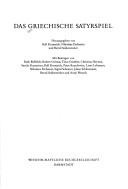| Listing 1 - 10 of 37 | << page >> |
Sort by
|
Book
Publisher: Caen : Delesques,
Abstract | Keywords | Export | Availability | Bookmark
 Loading...
Loading...Choose an application
- Reference Manager
- EndNote
- RefWorks (Direct export to RefWorks)
Book
Year: 1793 Publisher: Lipsiae : E libraria Mvilleria,
Abstract | Keywords | Export | Availability | Bookmark
 Loading...
Loading...Choose an application
- Reference Manager
- EndNote
- RefWorks (Direct export to RefWorks)
Book
Year: 1959 Publisher: Berlin : De Gruyter,
Abstract | Keywords | Export | Availability | Bookmark
 Loading...
Loading...Choose an application
- Reference Manager
- EndNote
- RefWorks (Direct export to RefWorks)
Greek drama (Satyr play) --- Vases, Greek. --- Illustrations.
Book
Year: 1974 Publisher: Athēna : Hetaireia Spoudōn Scholēs Mōraïtē,
Abstract | Keywords | Export | Availability | Bookmark
 Loading...
Loading...Choose an application
- Reference Manager
- EndNote
- RefWorks (Direct export to RefWorks)
Book

ISBN: 9783110725230 9783110725216 3110725231 3110725215 Year: 2021 Publisher: Berlin Boston
Abstract | Keywords | Export | Availability | Bookmark
 Loading...
Loading...Choose an application
- Reference Manager
- EndNote
- RefWorks (Direct export to RefWorks)
The origins of satyr drama, and particularly the reliability of the account in Aristotle, remains contested, and several of this volume’s contributions try to make sense of the early relationship of satyr drama to dithyramb and attempt to place satyr drama in the pre-Classical performance space and traditions. What is not contested is the relationship of satyr drama to tragedy as a required cap to the Attic trilogy. Here, however, how Aeschylus, Sophocles, and Euripides (to whom one complete play and the preponderance of the surviving fragments belong) envisioned the relationship of satyr drama to tragedy in plot, structure, setting, stage action and language is a complex subject tackled by several contributors. The playful satyr chorus and the drunken senility of Silenos have always suggested some links to comedy and later to Atellan farce and phlyax. Those links are best examined through language, passages in later Greek and Roman writers, and in art. The purpose of this volume is probe as many themes and connections of satyr drama with other literary genres, as well as other art forms, putting satyr drama on stage from the sixth century BC through the second century AD. The editors and contributors suggest solutions to some of the controversies, but the volume shows as much that the field of study is vibrant and deserves fuller attention.
Greek drama (Satyr play) --- Satyric drama, Greek --- Dionysia --- Greek drama
Book
ISBN: 3110796481 3110796600 Year: 2022 Publisher: Berlin ; Boston : De Gruyter,
Abstract | Keywords | Export | Availability | Bookmark
 Loading...
Loading...Choose an application
- Reference Manager
- EndNote
- RefWorks (Direct export to RefWorks)
With concern to Greek literature and particularly to 5th c. BCE tragic production, papyri provide us usually with not only the most ancient attestation but also the most reliable one. Much more so when the papyri are the only or the main witnesses of the tragic plays. The misfortune is that the papyri transmit texts incomplete, fragmentary, and almost always anonymous. It is the scholar’s task to read, supplement, interpret and identify the particular texts. In this book, five Greek plays that survived fragmentarily in papyri are published, four by Aeschylus and one by Sophocles. Three of them are satyr plays: Aeschylus’ Theoroi, Hypsipyle, and Prometheus Pyrkaeus; Sophocles’ Inachos belongs to the genre we use to call ‘prosatyric’; Aeschylus’ Laïos is a typical tragedy. The author’s scope was, after each text’s identification was secured as regards the poet and the play’s title, to proceed to textual and interpretative observations that contributed to reconstructing in whole or in part the storyline of the relevant plays. These observations often led to unexpected conclusions and an overthrow of established opinions. Thus, the book will appeal to classical scholars, especially those interested in theatrical studies.
Greek drama (Satyr play) --- Greek drama (Tragedy) --- Manuscripts (Papyri)
Book
ISBN: 9783825360641 3825360644 Year: 2013 Volume: 136 Publisher: Heildelberg: Universitätsverlag Winter,
Abstract | Keywords | Export | Availability | Bookmark
 Loading...
Loading...Choose an application
- Reference Manager
- EndNote
- RefWorks (Direct export to RefWorks)

ISBN: 3534145933 Year: 1999 Volume: 72 Publisher: Darmstadt Wissenschaftliche Buchgesellschaft
Abstract | Keywords | Export | Availability | Bookmark
 Loading...
Loading...Choose an application
- Reference Manager
- EndNote
- RefWorks (Direct export to RefWorks)
Greek drama (Satyr play) --- Drame satirique grec --- Criticism, Textual --- Critique textuelle --- -Satyric drama, Greek --- Dionysia --- Greek drama --- Criticism, Textual. --- -Criticism, Textual --- Greek drama (Satyr play). --- Satyric drama, Greek
Book
ISBN: 9780199950942 0199950946 Year: 2014 Publisher: Oxford: Oxford university press,
Abstract | Keywords | Export | Availability | Bookmark
 Loading...
Loading...Choose an application
- Reference Manager
- EndNote
- RefWorks (Direct export to RefWorks)
Greek drama (Satyr play) --- Greek drama (Comedy) --- History and criticism --- Satyric drama, Greek --- Dionysia --- Greek drama
Book
ISBN: 0865161976 0865161984 0865161984 Year: 1987 Publisher: Oak Park, Ill : Bolchazy-Carducci,
Abstract | Keywords | Export | Availability | Bookmark
 Loading...
Loading...Choose an application
- Reference Manager
- EndNote
- RefWorks (Direct export to RefWorks)
| Listing 1 - 10 of 37 | << page >> |
Sort by
|

 Search
Search Feedback
Feedback About UniCat
About UniCat  Help
Help News
News